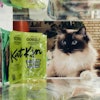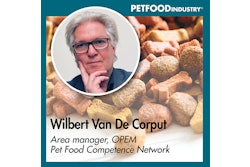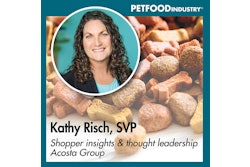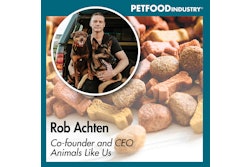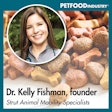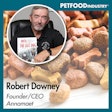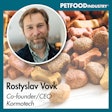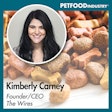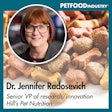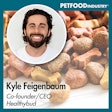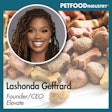
In this Trending: Pet Food podcast episode, Kristy Boulos, COO of Matrix Partners, highlights the critical role of market research in branding pet products, emphasizing its importance for understanding consumer preferences and differentiating products from competitors.
The below transcript is from Episode 68 of the Trending: Pet Food podcast. Host Lindsay Beaton talks with Kristy Boulos, COO of Matrix Partners, about why market research is crucial for understanding consumer preferences, differentiating products from competitors, and making informed branding decisions, especially in both the initial launch and ongoing development of pet brands. You can find the episode at Trending: Pet Food, on SoundCloud on your favorite podcast platform. This episode originally aired on August 20, 2024.
We want to thank Cargill for sponsoring this podcast. Cargill, a world leader in pet food ingredients and manufacturing, proudly offers TruMune postbiotic. TruMune is made to help modern pet food brands stand out by supporting multiple trending health claims — like gut health, balanced immunity and pet vitality. Best of all? TruMune benefits are packed into a single low-inclusion ingredient, and it’s backed by several pet-specific research studies
Lindsay Beaton – editor, Petfood Industry magazine, and host, Trending: Pet Food podcast: Hello, and welcome to Trending: Pet Food, the industry podcast where we cover all the latest hot topics and trends in pet food. I’m your host and editor of Petfood Industry magazine Lindsay Beaton, and I’m here today with Kristy Boulos, chief operating officer at Matrix Partners. Hi Kristy, and welcome!
Kristy Boulos, chief operating officer at Matrix Partners: Hi Lindsay. Thanks so much for having me today.
Beaton: In case you’re unfamiliar with Kristy or Matrix Partners, here’s what you need to know.
Kristy graduated with her master’s in advertising and public relations from DePaul University and has since spent nearly two decades creating, launching and growing consumer pet brands. As chief operating officer of Matrix Partners, she credits her in-depth understanding of pet parents’ buying habits to her years of experience and involvement in hundreds of pet parent focus groups.
Kristy knows what grabs a shopper’s eye, what evokes a reaction and even understands the diverse channels they shop and how that impacts the buying process. Her devotion to create products that truly make pet’s lives more enjoyable is the driving force behind everything she does at Matrix Partners.
Matrix Partners is a full-service marketing communications agency that focuses exclusively on the pet product industry and creating pet brands that enrich the human-animal bond. The agency works with brands at every stage, from concept development to launch and beyond.
Kristy’s breadth and depth of knowledge in the pet market, as well as consumer trends and branding strategy, are why I’ve brought her on today to answer this question: What is the importance of conducting market research throughout the branding process?
So, Christy, I want to start with a bit of a 101 question, so we can launch into what market research actually is. What is the general purpose and focus of market research? Why does it exist?
Boulos: Market research is important to have a lot of data to make important decisions, especially marketing decisions for a business. The market research you do can help generate insights into what motivates or drives a pet parent to try a customer's product. It also can help show it differentiates their product in a relevant way and what can stand out in a potential customer's mind.
Beaton: Now we have a lot of agencies who can help with things like that. What did companies do before there were agencies? A lot of the bigger companies have in-house marketing and branding and market research. Do they still benefit from third party help? Or do you find that it's the smaller and mid-sized companies who tend to need to outsource the market research?
Boulos: I see both. I see larger companies that sometimes want a different perspective. Their brand and their business aren’t growing as quickly as they'd like. They need an outside perspective. They have new management that's come in that wants to refresh their brand and look at what they should keep or what they should get rid of in what they're currently doing. It may be market research on products that customers are looking for, and they're looking at launching some new things in the new year.
It can also be smaller companies. A couple of big companies that we've worked with weren't big when we started with them, and they were looking for a general understanding of how people felt about their brands or their product concepts, and what they needed to capitalize on to continue to grow as a business and survive and thrive.
Beaton: Now, we are going to get into discussing the different points in branding and in a brand's lifecycle where market research needs to take place, but I want to talk about what is probably the most obvious part of the branding process where you need market research, and that is at the beginning.
What does it look like to do market research when you're thinking of either launching a new brand or revitalizing an existing brand?
Boulos: Market research is so important in those beginning phases when they're thinking of doing it so that they have a wealth of knowledge to make good, strong marketing decisions and recommendations based on what potential customers are telling us.
We might look at different logo design options. We might look at different color options. We also pay attention to things like language -- whether it's looking at press releases, looking at messages on packaging -- to get some insight into how people think or feel about certain keywords, what they like, what they don't like.
When we do make final packaging design communication recommendations, we tend to utilize a lot of the data that we get from these sessions and integrate it into a whole branding and communications plan for the brand.
Beaton: What are some of the questions you ask your clients that either people might not think of or might not seem an obvious question to ask when you're working with them at the beginning and building up your knowledge of the company's demographics and what it is they're looking for in their brand? What are those conversations like? What are some of the things you ask that surprise people?
Boulos: Every conversation that happens with a brand that's looking to revitalize themselves is challenging for several reasons.
One, it may be somebody that's extremely close to the brand, and they have a lot to be proud of for what they've built so far, but they also do see an opportunity. Some of those conversations get very personal when you're looking at rebranding and working with people that have been in the business since the beginning.
I can tell you a lot of the brand launches I've been in and been involved in, I'm still very close to the people that I spent so much time with -- before the focus groups through the branding process and afterwards. The things that I tend to ask is getting to understand why they're doing everything behind the brand first, why it looks the way it does, why it feels the way it does.
Instead of trying to just integrate industry knowledge that I have is finding the why. I think, why is it this way? Why did you build it this way? And getting a better understanding of why they did things and what they're hoping to achieve, so that I can come up with something that isn't revolutionary, that I can come up with something that's evolutionary.
I want the old owners or old brand managers or current brand managers to feel comfortable with and be proud of where it’s going, because it doesn't lose the heritage and what they've already built that they should be very proud of.
Whether it's a small business or larger business, I think really digging deep, getting to spend the time with people to understand why they did what they did, whether it's the colors, the logos, why they started the business, so that I have a greater understanding of and feeling for what they're hoping for.
Beaton: Now, I can understand that these kinds of conversations could really build trust between you and your clients, because you're showing that you care about their brand as it exists, and you don't want to come in wipe everything away and start completely over. You're not trying to say you know better than they do about their own brand, you want to make it better, so I can see how that builds that relationship and trust on their side.
From your perspective, is it also a good idea to operate like that, simply because, especially for you, you work exclusively in the pet space. Is it a way to keep all your clients from sounding the same and coming out the same, because, I imagine, once you've worked with as many pet companies as you've worked with, you've seen it all.
You've seen all the branding messages, and you've heard all the origin stories. Does it ever get difficult to find that hook that is going to make them completely different and not be derivative of something else you've done? Or do you find that their stories, when you get down to it, really are original enough that it makes it easy on your end?
Boulos: What we specialize in is trying to find what makes each company and brand unique and different. Usually, we'll do focus groups, but we'll couple that with a competitive analysis and look at the landscape. We look at who they believe their top competitors are, and who we believe a couple of their top competitors might be that they're not looking at. We make sure everything -- from their colors to their sounds to their brand voice to their tone -- sticks somewhat to their heritage but also focuses on a unique value proposition that does make them different from the other brand.
So yes, I do think it's an important part of the process to help extrapolate exactly what is unique and different about them, so that their branding is not only fitting to them, but it is also unique and different from what's already out there.
Beaton: So far, we've been talking about the obvious point where you do market research. I want to dive a little bit into the points where you believe companies need market research that they don't necessarily know or understand to come to you for or to conduct their own research.
What are some of those points where companies really need to not become complacent and continue to do market research with an existing brand?
Boulos: Thinking about this, with an existing brand, sometimes people over research. That's something that we'll talk about too. They have a lot of research, but they don't really know what to do with it. I think that lesser obvious would be, they have it, but they're like, it's not leading us to what we need, and it doesn't give us anything.
We can do a data dump for you, but it doesn't tell us anything. After we clear through the clutter, we may see some holes or opportunities that those outside-the-pet industry research teams didn't think to ask to get into the minds of a pet parent, so we've been able to help with that.
Sometimes people are like, “Oh, we already have this new product, and now we want to research and figure it out what people like about it.” Sometimes it's not too late, but if it's a line extension for a brand, well, it would have been good if we could have asked people ahead of time what kinds of ingredients they're looking for, what kinds of messaging, what kind of treat do they want? What are they looking for in their foods before they even get to the development of the product?
I find even with existing brands are doing line extensions, it's not that it's too late, but now we're backwards engineering the messaging to fit what customers are looking for, and they already have this product. There's not a whole lot we could do to change, but we could still change the communication package. We can change the design of the package to help better fit what customers are looking for, or what they did find were the positives of those products. There's a way to work it, but it's difficult when people say, “Here's this line I want to launch, and it hasn't been doing that well,” or, “I'm ready to launch now. I want to do some research.” It's almost a little too late.
Beaton: Lots of people do market research at the beginning of a brand, and then they launch it and say, it does well, and it's trucking along for maybe years. Then somebody pops in and goes, “Hey, have we refined our research lately to see if we're still hitting the people we want to hit?” How often do you recommend people do market research on their own brands -- not new, not anything coming out, but just their existing stuff to make sure they're still hitting their targets? How important a role does market research play in those kinds of ongoing success stories?
Boulos: Great question. We work with a lot of companies with small budgets who don't necessarily have a research/rebranding/relaunch budget every few years.
We work with companies a couple different ways. Sometimes we act as their entire marketing department. With smaller companies, we may do a one-time market research project or another service for them. For the larger companies we work with, it would be ideal to investigate building a five-year plan -- looking at the whole scope of their business, making sure we're on track for that plan, watching the sales data, watching things come through. If, for some reason, things look like they're far exceeding, which is obviously the ideal goal, what we had planned for, that's amazing. We’re looking at sales trends and trying to figure out exactly what is driving all that growth, what seems to be doing the best for their business.
As far as other companies that just do one-offs for us, generally they'll come back every time they want to launch something new. We don't have a lot of current clients that just run market research to stay up to date on what they currently have. We might not do focus groups or traditional research, but we do keep up with trends in the industry. For instance, we look at Petfood Industry and a lot of the great studies that you come out with looking at protein options, looking at what products are doing the best, looking what businesses are growing that could be potential competitors and what they're launching.
We utilize a lot of what you have as a resource in building out a bigger plan of what's to come, as far as market research and how people utilize it. Most of our clients do utilize it when they are launching new things into the market. Most of it is budgets as the reason we don't work with large enough companies that just have a budget set aside for market research every year or even every other year.
Occasionally, when they are looking to expand their product offerings, they will potentially do consumer focus groups or have us put together a customized presentation for the area of the industry that they're in, doing a competitive analysis using data from other studies in comparison, and then also us making recommendation – “If this is what the trends in the pet industry are showing us, these are great opportunities.” This is a direction or path forward that client would be able to manufacture. We know they'd be able to create something unique and different.
Beaton: I want to give a shout out to the small companies that you mentioned for a moment, because there are a lot of companies that enter the pet space, and they are like three or four people really trying hard to launch into a space that, in North America at least, is wildly saturated, has a lot of really established players, and they don't have budgets. I mean, their marketing person is also their salesperson and their social media person and possibly their CEO as well. Let's say they really, really must watch what they're spending, because their budget is zero, so anything they're spending, they're just immediately in the negative.
But you must do market research to be successful in this industry. When you're working with clients like that, what are the top things you recommend they focus on in their initial research to at least give them a chance to get into the industry and get established, and then maybe later, eventually, they do have a budget? But for now, what are the most important things people need to go to in terms of market research to feel like they can succeed?
Boulos: Part of it is looking at what their goal is. If they're doing a rebranding, what would I suggest? Looking at your competitors and making sure you're not on top of anybody else. I think a competitive analysis is going to be important. And you know, a lower cost option. It's not like you're flying in people or running to focus group facility. It's something that we do all the time and that a small company could do on their own as well.
Look at who your competitors are, look at the messages they're putting together, look at their brand colors, look at the types of fonts they're using, look at how they're communicating on social media, looking at their carousel images on online websites, on their own website -- learn about these other brands. Even though that seems counterintuitive, you want to know what your competition is up to and what they're doing. You want to make sure your message isn't the same as theirs, because you need to separate yourselves from the competition to a customer so the customer can easily tell what is unique and different about you and why they should buy your product over somebody else's.
Now, one of my least favorite ways of marketing is doing a direct comparison of why we’re better than Brand X because of XYZ. I tell all my clients, “Let's focus on what is great about you, because there's always something that we can find that is unique about you and your business and what you've built.” We capitalize and focus on that in all our communications, whether it's a design or actual communications on the website, social media, reaching out to customers. That is really, really important to small businesses.
Leveraging your team -- a network of pet lovers -- is also important. A lot of us in the pet business love other dog people. We have friends that have dogs. Every neighborhood dog has tried treats and chews for me. I ask friends and family, “Try this, see if your dog likes it. See how they feel about it, tell us what their reaction is.”
I don't believe in large-scale animal testing. Animals are very, very important to me and how we treat animals, so it's a way to do a test, but it's also you're just trying to give a friend's dog treats to try, a toy to play with, and just asking their opinion, giving some questions if it is a small business that can't afford large-scale research.
When I started working with Charlee Bear a few years ago when we did the rebranding, they had a brand manager who had been with the company since the beginning for 30 years, and she was the one that I worked really closely with on the rebranding. She created a document with five or six controlled questions, and whenever she would try new treats or try new flavors, she would pass that out to all her friends and family, and then collect those papers and put it all together to give us some market data. It was fascinating, and no one knew the brand and knows the brand as well as she does. She had a lot of great insight into how people thought about the brand and how people feel about the brand, and it ended up being greatly important to what we were doing.
Knowing your competition, testing and trying your product concepts with people that you know and trust, I think, is also really important for smaller scale businesses.
Beaton: I love that. I think that's a really, really good advice. A lot of the stuff at the beginning of putting together a company and entering this space can be difficult. It's a big investment. If you can just get a couple things and feel like you have a little bit of a foothold or any kind of knowledge or information on what your customers want, I feel like that could make people feel a lot better. In the end, that will help them to succeed, because they'll have more confidence in their brand and more confidence getting it out there on the shelves and trying to sell it to people.
Boulos: Absolutely. I agree with that 1,000%. There are people that are looking for support, and they should be very confident in what they're doing and what they're building, but I'll ask questions like, “What's different about your product? How’s your website performing?” They're like, “We don't need help with any of those things. We just want you to tell us how many units I should be making and how much money I'm going to make.”
I'm like, I don't know what your communications are. I know what your competition is doing based on my own knowledge of the industry and the breadth of clients I've worked on, but it was like a “me too,” and they didn't take a step back and think about what's already out there. They’re like, “Our supplements are different and better.” And I say, “That's great. What is different and better about them?” Or my treats are different and better, but really spending the time to get to know not only your own brand, but what is going to stand out and what's going to excite a customer.
Beaton: Let's talk about some successes that you have seen that you can relate back to market research that was conducted. Any companies that took a step to the right and then took a step to the left once they saw the research? Anything that you're particularly proud of or have seen in the industry that you use as a model?
Boulos: One of my first big successes in the industry was when we did a rebranding of Stella & Chewy’s. I had worked very closely with Marie Moody and the management team there. We had done market traditional focus groups, market research, and it was amazing the feedback that we got.
I feel like every time we do focus groups, we do research, we always learn something. Even though I've been in the industry for 20 years, I always learn something new coming out of those groups that I can use for that brand. Sometimes it's insights that I have in the back of my mind when I'm working on a project for another brand that was unrelated, but I'm constantly building up that knowledge. With Stella & Chewy’s, we walked out of there like, “Oh my goodness.” It was raw, freeze-dried food, and it was new to the industry. Newer. It was an amazing idea, an amazing concept. People walked out of there like, “I like the brown bag. I like the blue bag. Nobody had any idea what protein they were feeding. Nobody knew what brand it was or saying ‘I've seen that. I've bought that turquoise bag before.’”
One of the first things we did was do this all-American red banner of products that sitting on a store shelf really made an impact. It was unique and different for the raw category at the time. We made sure people knew exactly what those flavors were. Put the flavors front and center, because we never wanted people to mistake the brand they were buying again or what they were buying for their dog.
The other challenge we had was that a lot of people had perceived raw as being unsafe. Raw was still a very new concept, so we had to do some education, but we also built that safe raw bug coming out of those focus groups, so that people felt more comfortable. We emphasized they have different processes in place to make it a safe alternative to raw, the raw-freeze dried, but then they did also have the frozen patties available. It was really educating people on why Stella & Chewy’s was different.
Marie's story was obviously very catchy. I did a photo shoot with Stella and with Chewy before they passed, which was amazing. It was great to meet the dogs that really made it all happen. Marie and I have kept in touch over the years, and she's been wonderful to work with. Her business has done amazing things.
Charlee Bear dog treats is another great brand that we did the rebranding for. They have been in the market for 30 years and owned by the Gottsacker family. They only had Ava, the brand manager, who would drive around with treats in her car, selling them to different retailers. She was their main salesperson when we started doing social media for them eight years ago. They got a new person in management, and when they get new management, they sometimes have their own agencies they bring in or they're like, “What else can you do for us?”
We went into that meeting and told them, “We think there's a great opportunity for you to expand your customer base.” They kept asking, “Why are only older people -- based on the research we had and the data we had from social media -- why are only older people engaging with our brand? Why aren't there younger people excited about our brand?” We said, “It's the packaging. It's your packaging. It's your communications. You have a great product, you have loyal customers, and we want to expand that customer base.” We spent the time doing focus groups for them, also did competitive analysis for them, and spent a lot of time doing that branding.
They had a flagship line that they wanted to ensure there wasn't any consumer confusion on shelf for certain products. We did a very evolutionary package design for them -- integrated different brand blocking. Their two lines didn't look the same, so now everything looks similar. Over the years, we have been able to help them come up with new lines of products. We work with a team of people that help with formulations, but we come up with general concepts, and we talk to their sales team. We talk to the employees, and we get feedback. I still keep in touch with Ava, their old brand manager, all the time. I just talked to her the other day. We bounce ideas off each other, and she's such an important piece of that company that's always been there.
It's nice to have a sounding board, and we both care about the company so much that we try and do the best thing for it. We've integrated more of these in-home feeding trials with friends and family for Charlee Bear. I'm proud of that, that we've been able to do that. I was like, “Ava, we're carrying on your tradition. We're just widening our audience a little bit, but we are still sticking true to animals are in their home environment. It's people's pets, but using your questionnaires, they're just electronic now. It's easier to gather the data.”
We continually do different things for them, watching what is happening in the market, and making sure that we're implementing or bringing new products to market that makes sense for the industry. They are a business we work with that continuously does more market research. It's been a lot of fun to be along for the ride and learn a lot of new data from them.
Inaba -- we had the pleasure of doing a U.S. launch for them That was a lot of fun. It was a unique product. We work with a lot of unique brands, so it's easy, but then there's also an educational piece that comes with them. Anava was one of the first lickable treats that came into the U.S. They had a huge business over in Japan. Meeting with Mr. Inaba, he's like, “I want U.S. cats to have 15 or 20 of these a day.” I'm like, “Oh my goodness, that is a goal. That is a great goal.”
The packages, we didn't change the packaging. What we did was change and update some of the communications when we were launching it into the U.S. to make sure that we were appealing to a U.S. customer. We received a lot of great interest. The brand has grown substantially since it launched in the U.S., and there have been many brands that have created their own likable treats since that U.S. launch.
That was a lot of fun to work on as well, because it was so unique. Hearing people's reactions like, “Well, what do I do with this? I'm not sure my cat will like this.” Other people were like, “Oh, maybe it's good for medicine, or maybe I can squeeze it on food.” We sent people things after the focus groups too, and getting the feedback because it is highly palatable, and a lot of cats love it. We got a lot of great feedback from there as well.
Beaton: You've talked a lot about communications, and you've mentioned social media a few times. I want to sidebar into social media. It feels like these days, there are a million different ways to do the social media thing. What are you seeing right now in terms of popular social media outlets and successful social media outlets for the pet industry?
Boulos: Most of our clients do all their social media through Meta -- Facebook and Instagram. Instagram is a younger audience, but Facebook still has a very important older, engaged audience. The best part about Meta is they allow you to do a lot of different targeting.
We're doing a few brand launches right now where they're launching in certain markets. We're able to target the markets they're launching in to make sure the ad dollars are going to people that will potentially find these products in store. Some of the other social media platforms don't tend to make as much sense for manufacturers, like Pinterest. Pinterest was big for a long time, but that's good for people that are making recipes or DIY for your home. It doesn’t make as much sense for a pet product manufacturer.
TikTok is huge right now and growing. The only issue with TikTok is that a lot of the brands don't have a spokesperson that (A) has time to make a bunch of different videos or (B) even knows what to do in these videos. A lot of them -- it's real people behind the businesses. But there are a lot of people in accounting, there are a lot of people in finance that are running these businesses. It's fantastic – but it’s skillsets that some of us don't have, and communication and personality coming through and oing videos may not be something they excel at, so it’s not the best place for some of the brands.
Now for other brands … if Stella and Chewy were around when TikTok was big, then doing videos of their life story, that would be great. But a lot of brands are using UGC (user-generated content) and content creators that are creating content for them, which is also fruitful. But, you can't do the type of targeting on TikTok that you can do through Meta targeting right now.
I do still believe that companies want data. They want to see -- we're getting this many impressions. We're getting this many clicks. They want to see hard data. We want to make sure the audience we're reaching with their social media is reaching the right demographic for potential customer base for them. For us, Meta is still the most relevant place for us to be expanding out of social media.
Beaton: What do you believe is the most important communication point for a brand? Is it packaging? Is it their website? Is it retailers? Where is that key point that everything else can branch out from?
Boulos: It depends on what their goals are. If they are on-shelf for independent retailers, and they focus on the independent retailers and direct chains, packaging is going to be the most important for them, making sure the brand is front and center. Product differentiators are front and center. It’s not a very cluttered front of the package. You get in and get out in a few seconds. If a customer is interested enough, they'll pick it up and read more about the product on the back side.
If you are selling your products on your own website, then website communications are most important. I can't tell you how many websites that I go to. The team will tell you one of their favorite things that I do during a meeting is I run a quick SEO report and analysis. I look at -- not even the communications but how fast the website is, how it's loading to give me a better idea of what the customer experience is when they get to the website.
I think every website can do a better job of communications, but I think that speed of images loading … People want to have all the bells and whistles on their website, but if it takes more than one second to load. For every second, you lose 20% of the conversions of a customer on your website. Whether or not you're selling on your own website, you're just giving people information your own website, people don't want to deal with visiting a slow website that isn't working.
If I go to a website, and it's all white and I'm on my phone, I'm going to hit that X and jump off it. There are lots of studies that show that as well. That’s one of the funny things that people are like, “Oh no, our website is fine. It looks great.” And I visit and say, “I have no idea what you're selling.” Then I'll run this report while I'm on the call with them, and it'll say – you know the worst I ever saw was a website rating of six out of 100. It was somebody that was like, “Oh no, we're fine. We don't need any website support.” I said, “Okay, I trust your judgment, but I can show you that if people are Googling your product, it's not coming up because nobody has any idea of what your website is, what your product is or what you're selling.”
I really love the communication side of things. I love what I’ve learned from consumer research, because I think it's very important to integrate into all the communications that I'm doing. I think that communications, again, if it's in store on the package, might be all you have. Maybe POP, depending upon the store, if they'll allow you to put it in there. Things like shelf-talkers, danglers, brochures, samples are amazing vehicles to help brands, but making sure it's a nice sample that has the right communications on it. If you can be a little baggy and it has a logo on it, but I don't know what flavor it is, I don't know what the features or benefits are. It's not as worthwhile as “here's a website, here's the flavor,” so the customer can either come back and buy it or find it at another retailer or somewhere where they usually do their shopping.
For brands that are trying to get discovered and only sell either on their own website or even Amazon or Chewy, social media can drive people to your website. If they have a bad experience, they're not going to be interested. Something like 70% of people that visit a website and have a bad experience never come back.
Beaton: Since we've been talking a little bit about pitfalls, let's launch into that conversation a little deeper. What are some of the other pitfalls you've seen companies fall into with market research, either glaring gaps or at the beginning of our conversation, you mentioned over-researching or not knowing what to do with their research. What are some of the big pitfalls that research can lead you into, and how do you avoid it so that you can make the best use of your analysis?
Boulos: Like you mentioned, there are people that say, “We have all of this data, but we have no idea what to do with it.” Sometimes it's a lot of data that isn't necessarily relevant to what they're trying to do. We make our research unique to every brand and every product and what their goals are and what they're hoping to accomplish with the research rather than just giving you market data and looking at what dog owners are doing. It's almost too much, and then they don't know what to do with it.
Our research is more specific to help reach those goals. Again, is it a new product? Is it a brand relaunch, line extension? Very specific and very driven, so that all the activities we do follow along with what we're trying to accomplish, and we get actual answers to things that we can use. A lot of it is more qualitative than quantitative. We do quantitative research as well, which can also be very fruitful for brands.
When you're rebranding and updating communications, you have to have finesse, rather than a multiple choice ABCD question. Those kinds of things, though, are great for seeing brand awareness. Doing an attitude and awareness study, which we've done for brands as well. People will think, “Everybody knows about this brand.” But do they, though? Then you complete one of these attitude and awareness studies, and it's like, nobody knows about your brand. You have a great business, but you're scratching the surface.
That’s been eye opening for brands. They’re thinking, “Oh, we're fine.” And we're like, “No.” Especially as the industry gets more and more saturated with products and with competitors, it's important to have this research.
I would say over-research. Not doing any research and living in a bubble, like, “I've got this great new product and I want to launch it.” That was somebody a few weeks ago. I'm like, “What? No.” I know I keep saying “unique and different,” but what makes your products different and better? Why should I buy your product for my dog instead of X?
If they have a compelling reason, great, then I will be able to help market that. If they say, “Well, I made this product because I saw brand Y was selling a lot of it, and so it's like that but a less expensive version.” Yes, there's always room for less expensive version of things, but usually that means that something is not exactly like the other brand.
Beaton: As we wrap up our conversation, it sounds like market research is always evolving. You've been talking about how you like to focus on in-home studies and encouraging companies to just look at the customer pool around them and make use of that, because really, everybody out there who's a pet owner is a potential subject in terms of getting feedback on your products. How do you see market research in the pet space evolving in the next several years? What excites you about the space that you're in and what's next on the horizon for big research in pet?
Boulos: There have been more and more companies that are paying attention to pet and doing more research and data in pet. That’s what's going to be beneficial as the markets are changing and as the world is changing and brands don't want to invest as much money is finding more cost-conscious, faster research that's still effective.
I think finding fast, actionable, affordable ways to get some data and research for their brands and products that they can feel comfortable and confident in is going to be very important. Finding different vehicles, different pools of people they can get the data from will be very relevant to this industry moving ahead. The days of having $50,000 for a study, or even being able to pay $10,000 for 1,000 pages of data that they'd have to weed through to get to the 25 that are relevant to them, is a big investment. It's a smart investment, but it is a big investment for a lot of companies that are just starting out.
I think being more creative in the vehicles that are allowing people to do consumer research and ways to deliver that data to them in a way that makes sense is going to be even more important.
Beaton: I want to thank you for coming on the podcast today, because market research is a constant conversation in the industry. It's a big part of what we do on our side in terms of educating the industry, and market research is a huge, huge part of that. I think everybody thinks about doing market research when they're launching something new, or even when they're revitalizing, but there are so many other areas that market research could be beneficial. You don't want to get complacent in an industry that's as saturated as this one is, and with so much new coming out all the time, you really have to differentiate yourself. So thank you so much for coming on today and diving deep into that topic. I really appreciate it.
Boulos: Thank you so much. I know it's not the most exciting topic in the world, but it is a very important topic. I certainly appreciate your time.
Beaton: Before we go, I like to do a little plug for my guests. Where can people find more information about you and about Matrix Partners?
Boulos: You can find us on our website at matrix1.com. There are examples of a lot of the brands we've worked with over the years, as well as a list of our services and of our team. I’m incredibly proud of our team.
Our team does amazing things. I'm a jack of all trades, a master of none, and I have a fantastic team that supports us and allows us to dive deeper in specific areas that businesses may need support. You can also find us on TikTok and Facebook, Instagram, all the social media channels. You can look up Matrix Partners.
Beaton: Perfect. That's it for this episode of Trending: Pet Food. You can find us on petfoodindustry.com, SoundCloud or your favorite podcast platform. You can also follow us on Instagram @trendingpetfoodpodcast. And if you want to chat or have any feedback, I'd love to hear from you. Feel free to drop me an email: [email protected].
And of course, thanks again to our sponsor, Cargill. This world leader in pet food ingredients and manufacturing proudly offers TruMune postbiotic. TruMune is made to help modern pet food brands stand out by supporting multiple trending health claims — like gut health, balanced immunity and pet vitality. Best of all? TruMune benefits are packed into a single low-inclusion ingredient, and it’s backed by several pet-specific research studies.
Once again, I'm Lindsay Beaton, your host and editor of Petfood Industry magazine, and we'll talk to you next time. Thanks for tuning in!

